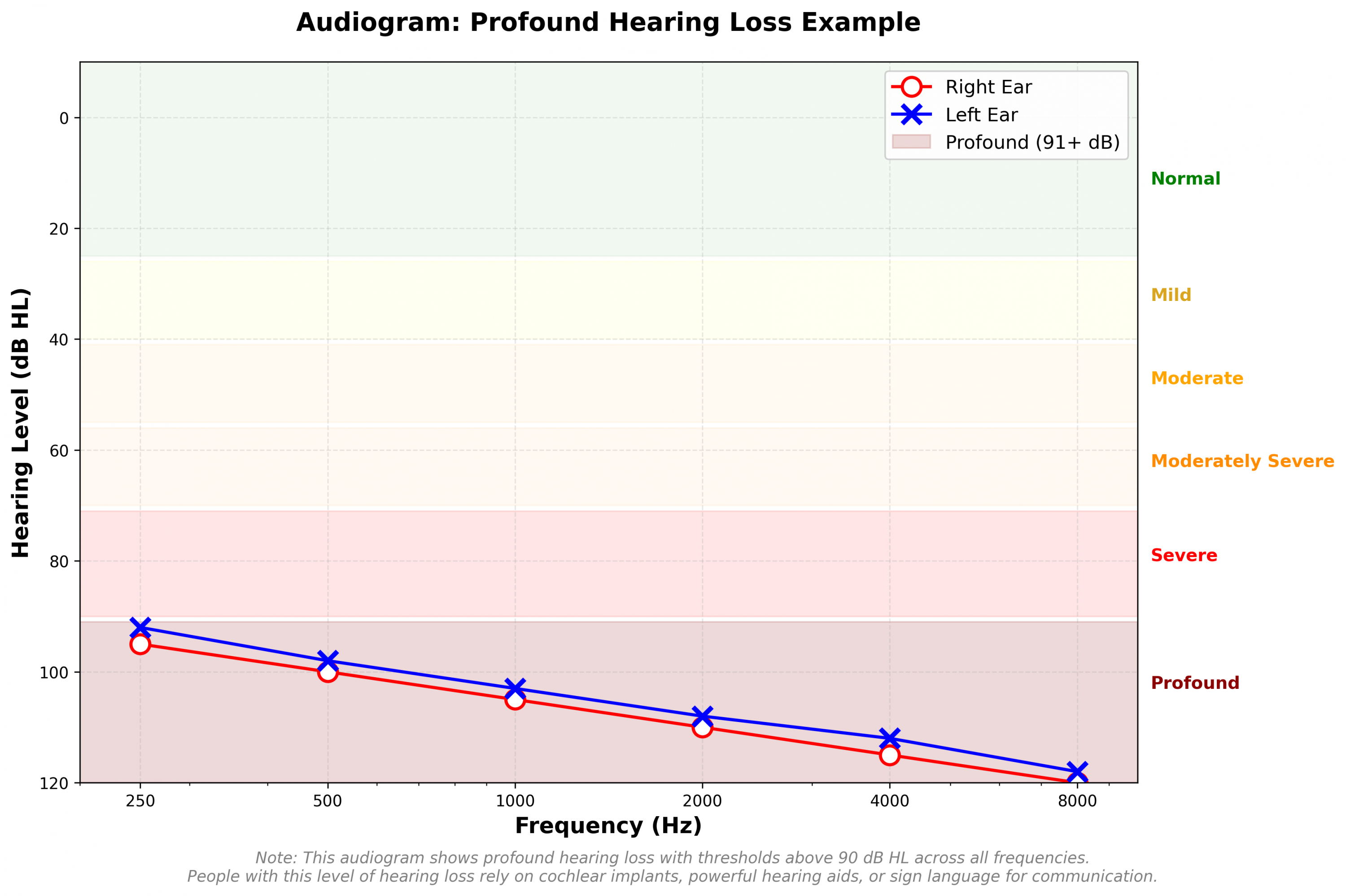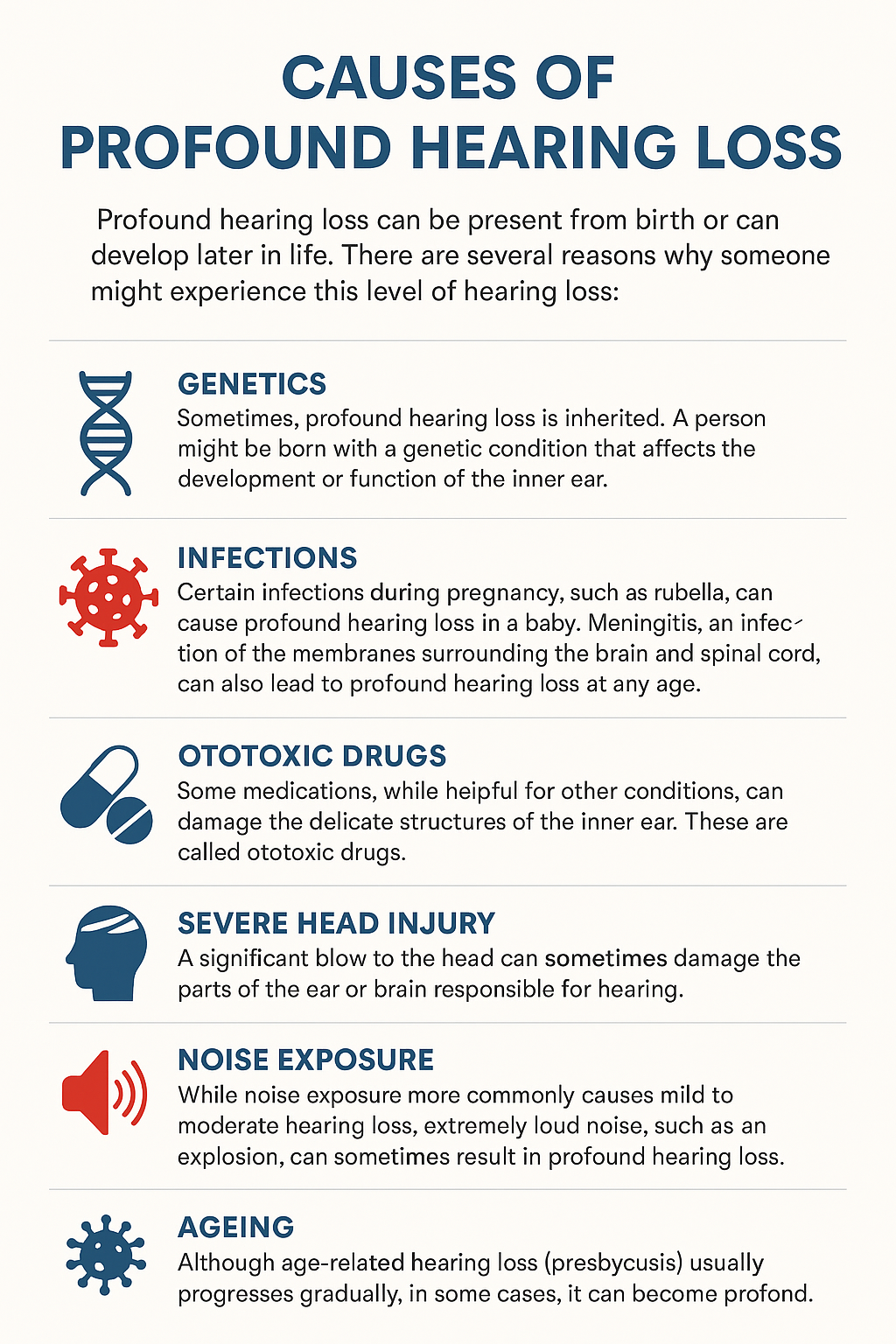
Head of Online Medical Content

Audiology Expert at Hearing Aid UK

What is Profound Hearing Loss?
Understanding this hearing loss, its symptoms, causes, and treatments
Overview | The hearing range | What is profound hearing loss? | The causes | Getting diagnosed | Living with profound hearing loss | Key takeaways | Conclusion
| Hearing Aid UK 2025-11-21 Update |
Overview
Profound hearing loss means very little or no hearing, making everyday sounds nearly impossible to detect. It can result from genetics, illness, injury, or ageing. Diagnosis involves specialised tests by an audiologist, like our experts at Hearing Aid UK.
Though challenging, people can manage it with support like sign language, cochlear implants, and visual aids. Early diagnosis is key to maintaining connection and quality of life.
In this article, we briefly go through the signs, challenges, causes, diagnosis, and how to manage profound hearing loss on a day to day basis.
A significant challenge
We all experience the world through our senses, and hearing is a big part of that. It connects us to people, helps us enjoy music, and keeps us aware of our surroundings. But what happens when hearing loss goes beyond just missing the odd word or two?
Let's talk about profound hearing loss, a significant challenge, but one that people navigate every day.
Understanding the hearing range
Before we dive into the specifics of profound hearing loss, it's helpful to understand the different degrees of hearing loss first. Audiologists, the healthcare professionals who specialise in hearing, measure hearing loss in decibels (dB).
Think of decibels as a way to measure the loudness of sound. Here's a general guide to the different types of hearing loss and the symptoms:
- Mild hearing loss: You might have trouble hearing soft speech or background noise.
- Moderate hearing loss: Conversational speech needs to be a bit louder for you to catch it.
- Severe hearing loss: You'd need very loud speech to hear, and even then, it might be difficult to understand.
- Profound hearing loss: This is the most significant level. Someone with profound hearing loss may only hear very loud sounds, if at all.
Related reading: Types of hearing loss

What does profound hearing loss mean?
So, what does it really mean to have profound hearing loss? In simple terms, it means that you have very little or no functional hearing.
Every day sounds that most of us take for granted, such as someone speaking at a normal volume, a phone ringing, or a car horn, are either not heard at all or are only heard as very faint vibrations.
The volume is turned down to almost zero. That's the reality for someone with profound hearing loss. It can make communication incredibly challenging and can affect many aspects of daily life.
Causes of profound hearing loss
Profound hearing loss can be present from birth or can develop later in life. There are several reasons why someone might experience this level of hearing loss:
- Genetics: Sometimes, profound hearing loss is inherited. A person might be born with a genetic condition that affects the development or function of the inner ear.
- Infections: Certain infections during pregnancy, such as rubella, can cause profound hearing loss in a baby. Meningitis, an infection of the membranes surrounding the brain and spinal cord, can also lead to profound hearing loss at any age.
- Ototoxic drugs: Some medications, while helpful for other conditions, can damage the delicate structures of the inner ear. These are called ototoxic drugs.
- Severe head injury: A significant blow to the head can sometimes damage the parts of the ear or brain responsible for hearing.
- Noise exposure: While noise exposure more commonly causes mild to moderate hearing loss, extremely loud noise, such as an explosion, can sometimes result in profound hearing loss.
- Ageing: Although age-related hearing loss (presbycusis) usually progresses gradually, in some cases, it can become profound.
- Illness: Certain illnesses can affect the auditory nerve or the inner ear.

How is it diagnosed?
Diagnosing profound hearing loss involves a thorough assessment by an audiologist. This assessment includes several key tests. Audiometry, the standard hearing test, involves wearing headphones and responding to sounds played at different frequencies and volumes.
In cases of profound hearing loss, the audiologist will be looking for responses to only the loudest sounds. Tympanometry checks the function of the middle ear and eardrum.
The Auditory Brainstem Response (ABR) test measures the electrical activity in the brainstem in response to sound and is often used for infants and young children, or when a more detailed assessment is needed.
Finally, the Otoacoustic Emissions (OAEs) test measures the tiny sounds produced by the inner ear, which are usually absent in cases of profound hearing loss.
Living with profound hearing loss
Living with profound hearing loss can be challenging, but it's important to remember that people with profound hearing loss can and do lead full lives with the right support and treatment. Communication is key, and several tools and strategies can help:
- Sign language: For many, sign language is the main means of communication. British Sign Language (BSL) is used in the UK.
- Lip reading: This involves watching a person's mouth movements to understand what they're saying.
- Hearing aids: While not always effective for profound hearing loss, very powerful hearing aids might provide some benefit for some people.
- Cochlear implants: These are small electronic devices that are surgically implanted and can be a very effective way to restore some hearing. They bypass the damaged parts of the inner ear and send electrical signals directly to the auditory nerve.
- Text messaging and email: These written forms of communication are invaluable.
- Visual aids: Flashing lights can be used for doorbells, fire alarms, and alarm clocks.
- Communication strategies: Such as face-to-face communication, allow for lip reading and the use of visual cues. Clear communication is also key. Speaking clearly and at a moderate pace can be helpful, along with patience and understanding.
Related reading: Communication strategies for those with hearing loss
The importance of an early diagnosis
For those with profound hearing loss, early intervention is so important. Profound hearing loss is a significant disability, but it doesn't have to be a barrier to a fulfilling life.
With the right support, technology, and communication strategies, people with profound hearing loss can connect with others, learn, work, and enjoy everything life has to offer.
Key takeaways
- Profound hearing loss is the most severe level of hearing loss, where everyday sounds are either not heard at all or perceived only as faint vibrations.
- Common causes include genetics, infections (like rubella or meningitis), ototoxic medications, severe head injuries, extreme noise exposure, and ageing.
- Diagnosis requires specialised testing by an audiologist, including audiometry, tympanometry, ABR tests, and OAE tests to measure hearing function.
- Management options include sign language (BSL in the UK), cochlear implants, powerful hearing aids, lip reading, text-based communication, and visual alert systems.
- Early diagnosis and intervention are important for maintaining quality of life and connection with others.
- People with profound hearing loss can lead full, fulfilling lives with the right support, technology, and communication strategies.
Summary
Profound hearing loss is the most severe level of hearing impairment, where even loud sounds may not be heard. It can be caused by factors like genetics, infections, head injuries, ageing, or certain medications. Diagnosis involves detailed hearing tests beyond standard checks.
While communication can be difficult, tools like sign language, cochlear implants, and visual aids help people lead full lives. Early diagnosis and support are essential for managing this condition effectively.
Why Choose Us?
- FREE Hearing Tests
- Best Hearing Aids and Prices
- FREE Aftercare for Life
- FREE Home Visits
- 200+ Local Audiologists
- 60 Day Money Back Guarantee
Do you think you have profound hearing loss?
Don't ignore it!
Don't let hearing loss hold you back. If you suspect you're having trouble hearing, take that important step and get your hearing checked.
It's about staying connected, engaged, and enjoying all the sounds of life to the fullest.
You can read the NHS online information leaflet on profound hearing loss here
Other hearing loss articles you might like...
 Tips for hearing in restaurants
Tips for hearing in restaurants  The impact of hearing loss and relationships
The impact of hearing loss and relationships  Hearing Loss and Mental Health
Hearing Loss and Mental Health Our specialist service includes:
Do not spend hundreds of pounds without getting a second opinion from us.
Please call us on 0800 567 7621
 Not only are the prices great, but the service is fantastic! Many thanks to your team.
Not only are the prices great, but the service is fantastic! Many thanks to your team.What's included in our hearing aid prices?
Watch the NHS video about profound hearing loss below
FAQs
In general, any audiologist will always recommend to you the hearing aid model that best suits your needs. Here is a useful checklist to make sure that is the case.
- Audiologist's level of knowledge: The audiologist you have seen will hopefully have a wide knowledge of all available hearing aids; however, some will only be familiar with a small number of brands and, therefore, may not really be in a position to know which model is the best for you. It is OK to challenge their recommendation and ask them to justify why this particular brand is the one for you.
- Do research: Read about the hearing aid that was recommended. Does it seem like it will suit your lifestyle? Does it have more or fewer features than you need?
- Be aware of sales targets: Many high street retailers have specific tie-ins to a particular manufacturer/brand. The hearing aid they have suggested may still be the correct one for you, but do your research so that you know why they might have recommended it.
If you have significant hearing loss in both ears, you should be wearing two hearing aids. Here are the audiological reasons why:
Localisation: The brain decodes information from both ears and compares and contrasts them. By analysing the minuscule time delays as well as the difference in the loudness of each sound reaching the ears, the person is able to accurately locate a sound source.
Simply put, if you have better hearing on one side than the other, you can't accurately tell what direction sounds are coming from.
Less amplification is required: A phenomenon known as “binaural summation” means that the hearing aids can be set at a lower and more natural volume setting than if you wore only one hearing aid.
Head shadow effect: High frequencies, the part of your hearing that gives clarity and meaning to speech sounds, cannot bend around your head. Only low frequencies can. Therefore, if someone is talking on your unaided side, you are likely to hear that they are speaking, but be unable to tell what they have said.
Noise reduction: The brain has its own built-in noise reduction, which is only really effective when it is receiving information from both ears. If only one ear is aided, even with the best hearing aid in the world, it will be difficult for you to hear in background noise as your brain is trying to retain all of the sounds (including background noise) rather than filtering them out.
Sound quality: We are designed to hear in stereo. Only hearing from one side sounds a lot less natural to us.
Fancy some further reading on this topic? You can read about why two hearing aids are better than one in our article, hearing aids for Both Ears, here
For most people, the main benefit of a rechargeable hearing aid is simple convenience. We are used to plugging in our phones and other devices overnight for them to charge up. Here are some other pros and cons:
For anybody with poor dexterity or issues with their fingers, having a rechargeable aid makes a huge difference, as normal hearing aid batteries are quite small and some people find them fiddly to change.
One downside is that if you forget to charge your hearing aid, then it is a problem that can't be instantly fixed. For most, a 30-minute charge will get you at least two or three hours of hearing, but if you are the type of person who is likely to forget to plug them in regularly, then you're probably better off with standard batteries.
Rechargeable aids are also a little bit bigger and are only available in Behind-the-Ear models.
Finally, just like with a mobile phone, the amount of charge you get on day one is not going to be the same as you get a few years down the line. Be sure to ask what the policy is with the manufacturer's warranty when it comes to replacing the battery.
For most people, the answer is yes. But it's never that simple.
The majority of hearing problems affect the high frequencies a lot more than the low ones. Therefore, open fitting hearing aids sound a lot more natural and ones that block your ears up can make your own voice sound like you are talking with your head in a bucket. Therefore, in-ear aids tend to be less natural.
However, the true answer is we can't tell until we have had a look in your ears to assess the size of your ear canal, and until we have tested your hearing to see which frequencies are being affected.
People with wider ear canals tend to have more flexibility, also there are open fitting modular CIC hearing aids now that do not block your ears.
There is also the age-old rule to consider, that a hearing aid will not help you if it's sat in the drawer gathering dust. If the only hearing aid you would be happy wearing is one that people can't see, then that's what you should get.
Most people can adapt to any type of hearing aid, as long as they know what to expect. Have an honest conversation with your audiologist as to what your needs are.
Generally speaking, six or more. Unless it's none at all. The number of channels a hearing aid has is often a simplistic way an audiologist will use to explain why one hearing aid is better than another, but channels are complex, and it is really not that straightforward. Here are some reasons why:
Hearing aids amplify sounds of different frequencies by different amounts. Most people have lost more high frequencies than low, and therefore need more amplification in the high frequencies. The range of sounds you hear is split into frequency bands or channels, and the hearing aids are set to provide the right amount of hearing at each frequency level.
Less than six channels, and this cannot be done with much accuracy, so six is the magic number. However, a six-channel aid is typically very basic with few other features and is suitable only for hearing a single speaker in a quiet room. The number of channels is not what you should be looking at; it's more the rest of the technology that comes with them.
As a final note, different manufacturers have different approaches. One method is not necessarily better than any other. For example, some manufacturers have as many as 64 channels in their top aids. Most tend to have between 17 and 20. One manufacturer has no channels at all.
Manufacturer's warranties typically last between 2-5 years, depending on the brand and model, and cover defects in materials and workmanship. This includes repairs for component failures, electronic malfunctions, and manufacturing defects, but excludes damage from misuse, accidents, or normal wear. Most manufacturers also include loss and damage insurance for the first year.
We handle all warranty claims on your behalf, liaising with manufacturers and ensuring you get replacement devices quickly when needed. This comprehensive warranty coverage, combined with our lifetime aftercare, gives you complete peace of mind.
Our hearing tests are completely free, whether at our clinics or in your home. Unlike other providers who charge £30-£100 for home visits, we believe hearing healthcare should be accessible without financial barriers. Our comprehensive assessments include examination by a registered audiologist, audiogram results, and personalised recommendations.
All testing, future adjustments, and ongoing support are included at no extra cost. While NHS tests are also free, typical 6-week waiting periods often lead people to seek immediate private testing. We provide prompt, professional assessments that fit your schedule and budget.
Yes, we offer completely free home visits throughout the UK, and this service is included in our prices with no additional charges. Home visits are particularly valuable for people with mobility issues, busy schedules, or those who simply prefer the comfort and convenience of their own environment.
Our audiologists can conduct full hearing tests, fit hearing aids, and provide ongoing support in your home. This service sets us apart from many providers who either don't offer home visits or charge extra for them.
We can offer prices up to 40% lower than high street retailers because of our business model. As a network of 200+ independent audiologists, we don't have the massive overheads of large retail chains - no expensive high street premises, no sales targets pushing audiologists to sell the most expensive options, and no costly marketing campaigns.
However, we maintain the same buying power as the big chains because we purchase on behalf of our entire nationwide network. This means you get access to the same premium hearing aids with professional service, but at genuinely competitive prices.
We offer a comprehensive 60-day money-back guarantee, which gives you twice the industry standard time to properly assess whether your hearing aids are right for you. This extended period recognises that adjusting to hearing aids takes time, and your brain needs several weeks to adapt to the amplified sounds.
Unlike many providers who offer just 30 days, we believe 60 days gives you the confidence to test your hearing aids in all the situations that matter to you - from quiet conversations at home to busy restaurants and outdoor activities.
Other pages you might find useful
Ask the Experts
6 Morton Lane
Walkwood
Redditch
Worcestershire
B97 5QA
Latest Launch
When we refer to a product as 'Latest Launch', we mean it is the latest to be released on the market.
New
When we refer to a product as 'New', we mean that the product is the newest hearing aid model on the market.
When we refer to a product as 'Superseded', we mean that there is a newer range available which replaces and improves on this product.
Older Model
When we refer to a product as an 'Older Model', we mean that it is has been superseded by at least two more recent hearing aid ranges.
